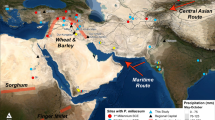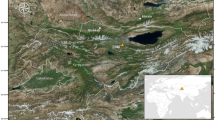Abstract
A large amount of carbonized plant remains were discovered in one of the outer burial pits of the Han Yangling Mausoleum, which was built more than 2000 years ago for the Jing Emperor, Liu, Qi (188—141 cal a BC), the fourth emperor of the Western Han Dynasty. The remains are identified by phytolith analysis and macrofossil morphological features. Seeds from foxtail millet (Setaria italica), broomcorn millet (Panicum miliaceum), rice (Oryza sativa) and chenopod (possible Chenopodium giganteum) are identified, suggesting that these four crops might have been the staple plant foods in the capital area (Guanzhong area), Shaanxi Province during the Early Western Han Dynasty. Chenopods were often considered as weeds since they have only been rarely found as carbonized seeds in prehistoric sites. This is the first time such a large amount of seeds has been found at a site, which provides strong material evidence for chenopod cultivation with a long history in China. Wheat was thought to be promoted and popularized in the Guanzhong area since the Wu Emporor, Liu, Che (156—87 cal a BC), the fifth emperor of the Western Han Dynasty. No wheat was found at this site, which supports the historical document record that wheat was still secondary in the diet and agrarian economy before the Wu Emperor’s reign.
Similar content being viewed by others
References
Xu Z Y. Han Agriculture: the Formation of Early Chinese Agrarian Economy (206BC-220AD). Seattle, London: University of Washington, 1980
Liu P X. Origins of Flourishing Age: Study on Han Agriculture Development (in Chinese). Nanjing: Jiangsu Provincial Historical Documents Press, 2001
Liu X L. On the archaeological discoveries and research work concerning the agriculture of Han Dynasty (in Chinese). J Lanzhou Univ (Soc Sci), 2005, 33(2): 11–19
Hunan Provincial Museum, Institute of Archaeology of CAS. Tomb 1 of the Han Dynasty at Mawangdui, Changsha (in Chinese). Beijing: Cultural Relics Press, 1973
Institute of Archaeology of CAS. Excavation Report on the Han Tomb at Mancheng (in Chinese). Beijing: Cultural Relics, 1980
Hubei Provincial Institute of Cultural Relics and Archaeology. Tomb 168 of the Han Dynasty at Fenghuangshan, Jiangling (in Chinese). Chin Archaeol, 1993, (4): 455–514
Museum of Zhuang Nationality Autonomous Region, Guangxi. Han Tombs at Gui County, Guangxi (in Chinese). Beijing: Cultural Relics Press, 1988
Jiao N F. Preliminary study on outer burial pits of Han Yangling Mausoleum (in Chinese). Cult Relics, 2006, (7): 51–57
Shaanxi Provincial Institute of Archaeology. The second excavation report on the outer burial pits of Southern Han Yangling Mausoleum of Jing Emperor (in Chinese). Cult Relics, 1994, (6): 4–23
Lu H Y, Wu N Q, Yang X D, et al. Phytoliths as quantitative indicators for the reconstruction of past environmental conditions in China I: phytolith-based transfer functions. Quat Sci Rev, 2006, 25: 945–959
Lu H Y, Zhang J P, Wu N Q, et al. Phytoliths analysis for the discrimination of Foxtail millet (Setaria italica) and Common millet (Panicum miliaceum). PLoS ONE, 2009, 4(2): e448, doi:10.1371/journal.pone.0004448
Editorial Committee of Chinese Flora, CAS. Chinese Flora: Families of Chenopod and Amaranth, Class of Dicotyledon, Phylum of Angiosperm (in Chinese). Fascicule 2, Volume 25, Beijing: Science Press, 1979. 95–96
Smith B D. Chenopod as a prehistoric domesticate in Eastern North America: Evidence from Russel Cave, Alabama. Science, 1984, 226: 165–167
Hunan Provincial Institute of Archaeology. Pengtoushan and Bashidang (in Chinese). Beijing: Science Press, 2006. 518–543
Crawford G, Zhao Z J, Luan F S, et al. Longshan Cultural plant remains at Liangchengzhen site, Shandong (in Chinese). Chin Archaeol, 2004, (9): 72–80
Zhao Z J. Dry farming origins in North China: a perspective by the results of floatation at Xinglonggou site. In: Nanjing Normal University, ed. East Asian Archaeology (in Chinese). Beijing: Cultural Relics Press, 2004. 188–199
Chen W H. Agricultural Archaeology (in Chinese). Beijing: Cultural Relics Press, 2002
Yan W M. The Origins of Agriculture and the Rise of Civilization (in Chinese). Beijing: Science Press, 2000
Wu Y L. Neolithic rice Agriculture in the Yellow River region (in Chinese). Agr Archaeol, 1994, (1): 78–84
Zhao Z J. Characteristics of agrarian economy during formation of Xia, Shang, Zhou Civilizations (in Chinese). Huaxia Archaeol, 2005, (1): 75–81
Li X Q, Zhou X Y, Zhang H B, et al. The record of cultivated rice from archaeobiological evidence in northwestern China 5000 cal. a BP ago. Chin Sci Bull, 2007, 52: 1372–1378
Luoyang Archaeological Excavation Team. Excavation report on Han tombs in west suburb of Luoyang City (in Chinese). Chin Archaeol, 1963, (2): 48–49
Wei X T, Kong Z C, Liu C J. Discovery and significance of Yangshao Cultural rice remains at Nanjiaokou site, Sanmenxia City (in Chinese). Agric Archaeol, 2000, (3): 77–79
Xu Z Y. Han Agriculture: the Formation of Early Chinese Agrarian Economy (206 BC-220AD) (in Chinese). Nanjing: Jiangsu People’s Press, 1998. 88–98
Wei S. A history of large-scale wheat cultivation in Han Dynasty (in Chinese). Chin Agric His, 1988, (4): 22–30
Zhao S L, Chang S. Promotion and popularization of winter wheat cultivation during Han Dynasty in North China (in Chinese). Chin His Geogr, 1999, (2): 37–46
Jin G Y. On the archaeological discoveries and research works of the early wheat in China (in Chinese). Agric Archaeol, 2007, (4): 11–20
Wang R X. Collected Works on Food Archaeology (in Chinese). Beijing: Chinese Commercial Press, 1994
Li F L. Preliminary study on ancient stone milling tools (in Chinese). Agric Archaeol, 1986, (2): 146–167
Author information
Authors and Affiliations
Corresponding author
Additional information
Supported by National Natural Science Foundation of China (Grant No.40771205), National Science Fund for Distinguished Young Scholars (Grant No. 40625002), Chinese Civilization Origins Project (Grant No. 2006BAK21B20) and Knowledge Innovation Project from Chinese Academy of Sciences (Grant No. KZCX2-YW-315-5)
About this article
Cite this article
Yang, X., Liu, C., Zhang, J. et al. Plant crop remains from the outer burial pit of the Han Yangling Mausoleum and their significance to Early Western Han agriculture. Chin. Sci. Bull. 54, 1738–1743 (2009). https://doi.org/10.1007/s11434-009-0048-z
Received:
Accepted:
Published:
Issue Date:
DOI: https://doi.org/10.1007/s11434-009-0048-z




